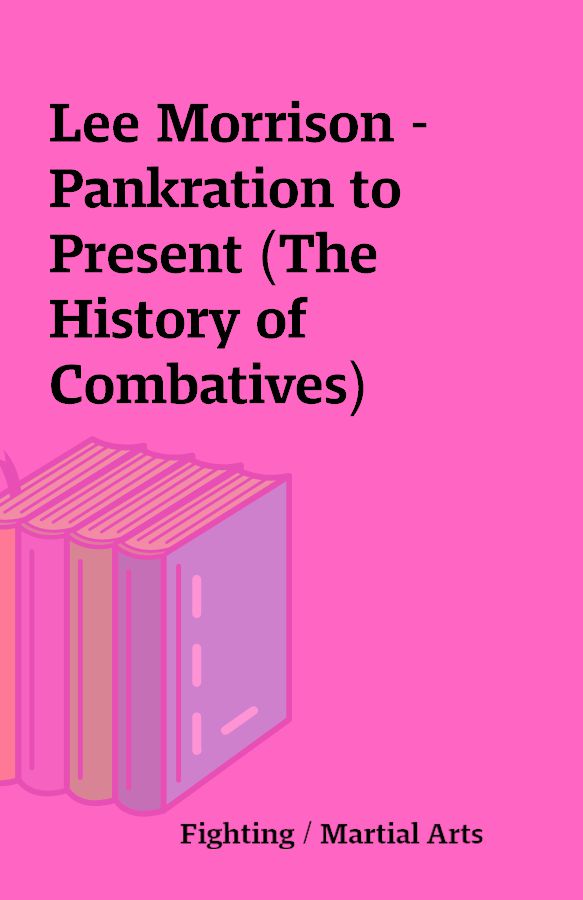Lee Morrison – Pankration to Present (The History of Combatives)
Lee Morrison – Pankration to Present.pdf
[1 eBook – PDF]
Description
Product Description Introduction The Pankration The Middle Ages Early Japanese Ju-Jitsu Bare Fist Fighting Savate & La Canne Bartitsu The Combative Methods of WWI The Shanghai Connection The Combatives of WWII Post War Unarmed Combat Enter the Martial Arts Military Close Combat Reality Based Self Defence Modern Combatives A Comparison of Martial Methods Throughout the Centuries The Future Sources & AcknowledgmentsProduct ReviewsFor a book-worm like me it was a great pleasure when Lee told me that he was working on this book, I think it must have been back in 2005 sometime. I’d been eagerly awaiting its release when I spotted it, an update on his website saying the book had been released. An immediate text followed and I’d snagged myself a pre-release copy to take to bed and help burn the midnight oil!I thought that Lee was a very brave man to tackle such a vast and fragmented topic; I wondered how he would ever be able to cover off all of the bases. When I opened the book I understood the focus of Lee’s work – western combatives.Now before I get going on the actual review I’d like to make a point, perhaps I’m getting on my soapbox here but nevertheless. There will be some who disparage what Lee has done – he has missed this, he has misinterpreted that, so-and-so is missing, such-and-such was not included. I would agree with those people, Lee will have missed out people, places, events and “systems”. He will have interpreted things differently from others, and he will have got some facts wrong. But, and this is my point, he has made the effort to pen over 250 pages of very interesting information from what is available to him. He cannot and should not be belittled for not knowing that Bruce Lee’s Great-Grandmother was a Blue Belt in BJJ if it is a fact that has been kept secret, make sense? What I would say is that if you think anything has been left out, any facts are incorrect etc., just let Lee know for the re-print….don’t start a flame war in some corner of the web.Ok, I’m off the soapbox…on to the meat of it all!Lee’s book, for me, is 250+ pages of great info. He’s managed to bring together a lot of the aspects that many people today know nothing or very little about. He has done some great research of both primary texts and secondary sources available on the web. The book has small forays into the world of combat sports, to support other aspects/arguments, but overall it stays true to Lee’s wish of only discussing combatives. Examples of what Lee terms as combative, and what he sees as its core principles, are given in the book and supported with anecdotes and quotes from others.You can get a good idea of what you’ll be getting from the chapter headings, and this is all supported by relevant pictures, quotes and original commentary. Some of our favourite names of years past are mentioned; people such as W.E. Fairbain, E.A. Sykes, Bill Underwood, John Styers, Charlie Nelson, and Rex Applegate. Names currently “on the scene” in some way shape or from are covered such as Dennis Martin, Dave Turton, Geoff Thompson, CODA, Kelly McCann, and Carl Cestari. Names that will be new to many people such as E.W. Barton-Wright, Pierre Vigny, Leopold McLaglan, and Arrichion come forth. There is a treat in there, I think, for even the most avid combatives geek out there!The book discusses how the combative arts have grown and changed since the early Pankration of the Greeks through to today’s packages of WWII Combatives, Modern Combatives, and RBSD (Reality Based Self Defence). How various trends have had an impact on the perceived combative nature of martial arts; the Kung Fu craze, the plethora of Ninja popping up from nowhere, the impact of Judo and Ju-Jitsu. The book also looks to the future, what will happen with the changes that are happening in today’s society with events such as 9/11 and 7/7.A treat for me was the “Comparison of Martial Methods” chapter, where Lee takes a look at the similarities in techniques and tricks of Egypt circa 200BC, 1500’s Germany and WWI for example. He takes images from one era and puts them aside images from a totally different era showing how many of the combative techniques we use today are reinventions. This may be on a purely technical side we cannot say, I for one would not want to meet a trench-hardened WWI NCO or veteran Pankration fighter in a dark London alley! Lee has done the hard work in putting these comparisons together so that people like I can say “yeah, I knew that was the case.”Lee has a real passion for anything combative, which I would imagine is why he gave himself such a hefty task as this book. His passion comes out in the writing, like it does in his teaching and presentation. You can tell from reading the text that he is loving every minute of what he’s telling you, it’s easy for those who know him to imagine his gesticulations as he gets to a particularly gritty part of the book. That’s something I feel is a real winner here, the book is written by someone who loves the subject matter – it’s not a book to cash in on a trend or to make money, it’s a book written with honest enthusiasm and a desire to share (and increase) knowledge of the field.Today there are a lot of people interested in WWII Combatives and/or Modern Combatives. This book goes a long way to answering some of their questions about who / what / when / why. The resources section gives some great pointers for people wanting more information, and there are plenty of names mentioned in the text who have their own systems on DVD and on paper…plenty for the enthusiast to sink their teeth into. The book shows that there was more to WWII that Fairbairn, Sykes and Applegate, the names commonly associated with WWII Combatives. More to wrestling than lycra clad WWF’ers, and more to boxing than Ali and Tyson.I haven’t given you too much here I know, but I hope I’ve given you a flavour of what to expect from the book. To give you all would make this not a review, but a posh photocopy. Suffice to say I enjoyed the book (as can be seen from me taking only a week to read it, and trust me that’s fast for someone who lives in Essex!), and I’d be happy to part with some cash for a copy…I’m actually thinking of it as a good Christmas present for a few friends.James Farthing
You must be logged in to post a review.






Reviews
There are no reviews yet.